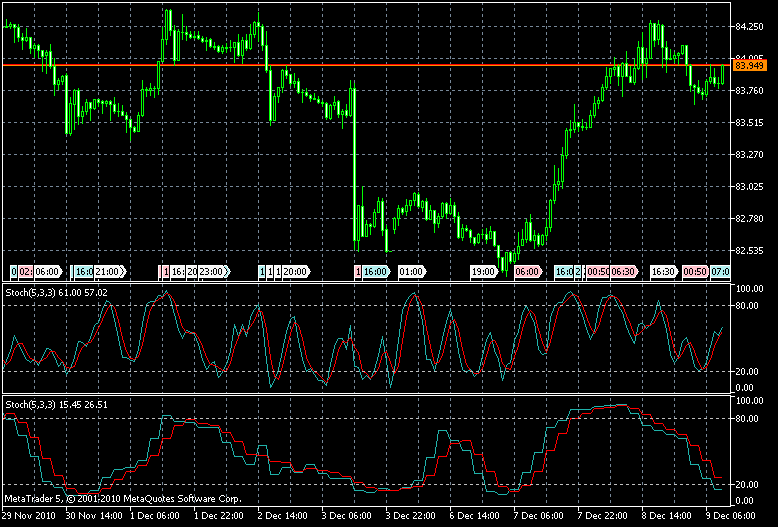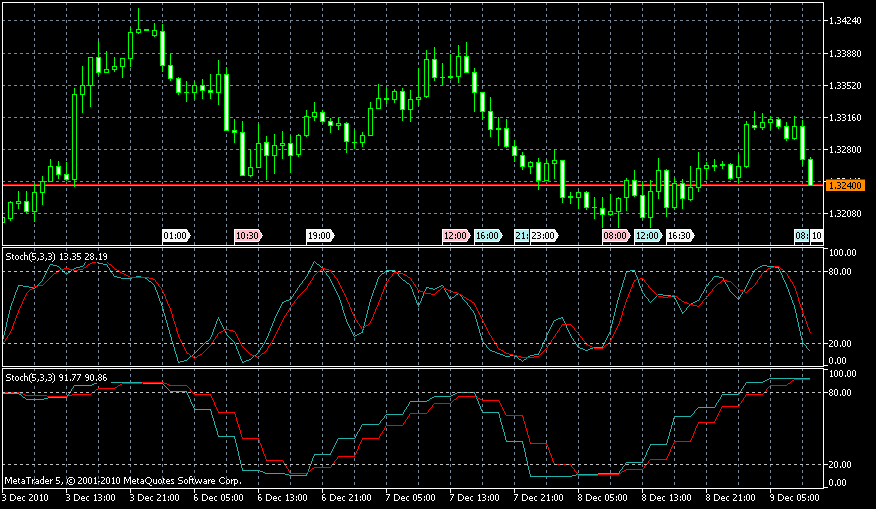【解説】【MQL5 community】 iStochasticOfOsc : Stochasticと同様。 レンジ相場の時に有効といわれ, 買われ過ぎ、売られ過ぎを判断する指標である. 特にここでは iStochasticOfOscを利用して、マルチタイム表示にしている。
短期線:Fast%K(n)=(当日終値−n期間の最安値)÷(n期間の最高値−n期間の最安値)×100(%)
中期線:Fast%D(n)=(当日終値−n期間の最安値)のm期間合計÷(n期間の最高値−n期間の最安値)のm期間合計×100(%)
長期線:Slow%D(I)=Fast%DのI期間の移動平均
【シグナル】
「買いゾーン(20%以下)において、%Kが%Dを下から上へ抜けたときが売られ過ぎのサインで、買い」
「売りゾーン(80%以上)において、%Kが%Dを上から下へ抜けたときが買われ過ぎのサイン、売り」
//+------------------------------------------------------------------+
//| Stochastic MTF.mq5 |
//| Copyright ゥ 2010, AK20 |
//| traderak20@gmail.com |
//+------------------------------------------------------------------+
#property copyright "2010, traderak20@gmail.com"
#property description "Stochastic, Multi-timeframe"
#property version "V02"
#property indicator_separate_window
#property indicator_buffers 2
#property indicator_plots 2
//--- indicator plots
#property indicator_type1 DRAW_LINE
#property indicator_type2 DRAW_LINE
#property indicator_color1 LightSeaGreen
#property indicator_color2 Red
#property indicator_width1 1
#property indicator_width2 1
#property indicator_label1 "Main_TF2"
#property indicator_label2 "Signal_TF2"
//--- input parameters
input ENUM_TIMEFRAMES InpTimeFrame_2=PERIOD_H1; // Timeframe 2 (TF2) period
input int InpKPeriod=5; // K period
input int InpDPeriod=3; // D period
input int InpSlowing=3; // Slowing
input ENUM_MA_METHOD InpAppliedMA=MODE_SMA; // Applied MA method for signal line
input ENUM_STO_PRICE InpAppliedPrice=STO_LOWHIGH; // Applied price
//--- indicator buffers
double ExtMainBuffer_TF2[];
double ExtSignalBuffer_TF2[];
//--- arrays TF2 - to retrieve TF 2 values of buffers and/or timeseries
double ExtMainArray_TF2[]; // intermediate array to hold TF2 main buffer values
double ExtSignalArray_TF2[]; // intermediate array to hold TF2 signal buffer values
//--- variables
int PeriodRatio=1; // ratio between timeframe 1 (TF1) and timeframe 2 (TF2)
int PeriodSeconds_TF1; // TF1 period in seconds
int PeriodSeconds_TF2; // TF2 period in seconds
//--- indicator handles TF2
int ExtStochasticHandle_TF2; // stochastic handle TF2
//--- turn on/off error messages
bool ShowErrorMessages=false; // turn on/off error messages for debugging
//+------------------------------------------------------------------+
//| Custom indicator initialization function |
//+------------------------------------------------------------------+
void OnInit()
{
//--- indicator buffers mapping
SetIndexBuffer(0,ExtMainBuffer_TF2,INDICATOR_DATA);
SetIndexBuffer(1,ExtSignalBuffer_TF2,INDICATOR_DATA);
//--- set accuracy
IndicatorSetInteger(INDICATOR_DIGITS,2);
//--- set levels
IndicatorSetInteger(INDICATOR_LEVELS,2);
IndicatorSetDouble(INDICATOR_LEVELVALUE,0,20);
IndicatorSetDouble(INDICATOR_LEVELVALUE,1,80);
//--- set maximum and minimum for subwindow
IndicatorSetDouble(INDICATOR_MINIMUM,0);
IndicatorSetDouble(INDICATOR_MAXIMUM,100);
//--- calculate at which bar to start drawing indicators
PeriodSeconds_TF1=PeriodSeconds();
PeriodSeconds_TF2=PeriodSeconds(InpTimeFrame_2);
if(PeriodSeconds_TF1<PeriodSeconds_TF2)
PeriodRatio=PeriodSeconds_TF2/PeriodSeconds_TF1;
PlotIndexSetInteger(0,PLOT_DRAW_BEGIN,(InpKPeriod+InpSlowing-2)*PeriodRatio);
PlotIndexSetInteger(1,PLOT_DRAW_BEGIN,(InpKPeriod+InpDPeriod)*PeriodRatio);
//--- name for indicator
IndicatorSetString(INDICATOR_SHORTNAME,"Stoch("+(string)InpKPeriod+","+(string)InpDPeriod+","+(string)InpSlowing+")");
//--- get Stochastic handle
ExtStochasticHandle_TF2=iStochastic(NULL,InpTimeFrame_2,InpKPeriod,InpDPeriod,InpSlowing,InpAppliedMA,InpAppliedPrice);
//--- set arrays as series, most recent entry at index [0]
ArraySetAsSeries(ExtMainBuffer_TF2,true);
ArraySetAsSeries(ExtSignalBuffer_TF2,true);
ArraySetAsSeries(ExtMainArray_TF2,true);
ArraySetAsSeries(ExtSignalArray_TF2,true);
//--- initialization done
}
//+------------------------------------------------------------------+
//| Stochastic Oscillator |
//+------------------------------------------------------------------+
int OnCalculate(const int rates_total,
const int prev_calculated,
const datetime &Time[],
const double &Open[],
const double &High[],
const double &Low[],
const double &Close[],
const long &TickVolume[],
const long &Volume[],
const int &Spread[])
{
//--- check for data
int bars_TF2=Bars(NULL,InpTimeFrame_2);
if(bars_TF2<InpKPeriod+InpDPeriod+InpSlowing)
return(0);
//--- not all data may be calculated
int calculated_TF2;
calculated_TF2=BarsCalculated(ExtStochasticHandle_TF2);
if(calculated_TF2<bars_TF2)
{
if(ShowErrorMessages) Print("Not all data of ExtStochasticHandle_TF2 has been calculated (",calculated_TF2," bars). Error",GetLastError());
return(0);
}
//--- set limit for which bars need to be (re)calculated
int limit;
if(prev_calculated==0 || prev_calculated<0 || prev_calculated>rates_total)
limit=rates_total-1;
else
limit=rates_total-prev_calculated;
//--- create variable required to convert between TF1 and TF2
datetime convertedTime;
//--- loop through TF1 bars to set buffer TF1 values
for(int i=limit;i>=0;i--)
{
//--- convert time TF1 to nearest earlier time TF2 for a bar opened on TF2 which is to close during the current TF1 bar
//--- use this for calculations with PRICE_CLOSE, PRICE_HIGH, PRICE_LOW, PRICE_MEDIAN, PRICE_TYPICAL, PRICE_WEIGHTED
convertedTime=Time[i]+PeriodSeconds_TF1-PeriodSeconds_TF2;
//--- check if TF2 data is available at convertedTime
datetime tempTimeArray_TF2[];
CopyTime(NULL,InpTimeFrame_2,calculated_TF2-1,1,tempTimeArray_TF2);
//--- no TF2 data available
if(convertedTime<tempTimeArray_TF2[0])
continue;
//--- get main buffer values of TF2
if(CopyBuffer(ExtStochasticHandle_TF2,0,convertedTime,1,ExtMainArray_TF2)<=0)
{
if(ShowErrorMessages) Print("Getting Stochastic TF2 failed! Error",GetLastError());
return(0);
}
//--- set main TF2 buffer on TF1
else
ExtMainBuffer_TF2[i]=ExtMainArray_TF2[0];
//--- get signal buffer values of TF2
if(CopyBuffer(ExtStochasticHandle_TF2,1,convertedTime,1,ExtSignalArray_TF2)<=0)
{
if(ShowErrorMessages) Print("Getting Signal TF2 failed! Error",GetLastError());
return(0);
}
//--- set signal TF2 buffer on TF1
else
ExtSignalBuffer_TF2[i]=ExtSignalArray_TF2[0];
}
//--- return value of rates_total, will be used as prev_calculated in next call
return(rates_total);
}
//+------------------------------------------------------------------+
【表示結果】


上段が1H、下段が3HのStochastic
Back to Meta Trader










